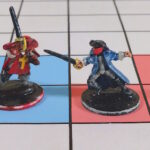 It’s time.
It’s time.
Your seconds stand in silent testimony.
The trash talking has been silenced. The dancing is over. You and your 15mm opponent have finally reached the moment of the plunge into violence.
In Alternative Armies’ En Garde, when the steel meets the flesh, the players have some important decisions to make. Each attacker has a total of six options for the thrust, each with its own benefits and drawbacks, such as:
- Flurry of blows allows you to make two attacks at a penalty
- Slashing attack allows you to strike with a penalty, but any hit forces your opponent back one square
- Stand and strike offers no bonuses, but offers no restrictions, either
- Disarm does exactly what you expect it to
Of course, not all weapons are suited to all attacks. You can’t make a slashing attack with a rapier, for example.
In a standard duel the attacker selects his attack and secretly identifies it somehow. He might write it down on paper, or select a chit from a cup, or turn a d6’s face up. Once he has selected his attack, the defender announces what he is defending against. In other words, he is trying to guess what his opponent has chosen as his attack. If he guesses right, the attack fails.
The odds of guessing right would seem to the average person to be one-in-six. But consider that not all fighters know all six routines. You get three for free, but have to pay for the rest. And as we mentioned already, not all weapons can do all six attacks. You’ll typically only have three or four options, and one or two of those might not even be viable given the tabletop situation. It’s a neat little sub-system and very evocative of the source material.
But what about us solo gamers? We can’t exactly bluff ourselves.
I don’t have a great answer. The best I can do is AN answer, and it’s about what you would expect.
Call your shot for the attacker. Then, knowing how many potential options the attacker has available, roll a die of that size. If the result is a 1, the defender has successfully called the shot. Rather than slow the game down by trying to match the die to the attack routine, or pulling one chit out of a cup with the possible routines in it, just shoot for a 1.
This does mean that duelists with more options are less likely to have their attack blocked. As it should be.
For movement and die-type selection, you can pretty much double-fist things with a bit of role-playing added for variety. Nominate one figure as aggressive and pull higher die types, the other as reticent and stick to the lower die types. See what happens. It’s not the same feel as trying to outguess or outmaneuver a flesh and blood player, but it does allow the solo gamer to explore the other intricacies and eccentricities of En Garde.

